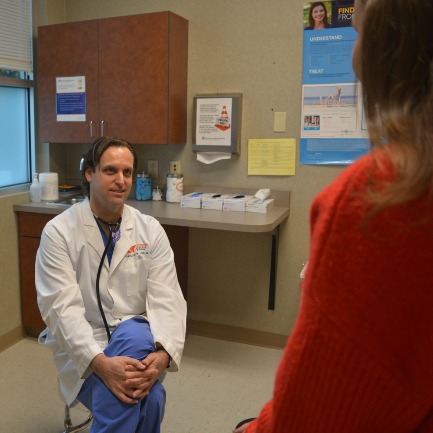AS LIFE-THREATENING AS A HEART ATTACK OR STROKE
 Diabetes is major health issue in the United States, and in the southeast, approximately 15 percent of the population is diabetic. It’s known that diabetes doubles the risk for heart disease in men and triples the risk of heart disease in women. And in Hamilton County, there are approximately 55,000 people living with this dangerous and potentially life-threatening condition. When it comes to appropriate diabetes care, there’s a lot to do – control blood sugar, watch out for eye problems and monitor foot infections.
Diabetes is major health issue in the United States, and in the southeast, approximately 15 percent of the population is diabetic. It’s known that diabetes doubles the risk for heart disease in men and triples the risk of heart disease in women. And in Hamilton County, there are approximately 55,000 people living with this dangerous and potentially life-threatening condition. When it comes to appropriate diabetes care, there’s a lot to do – control blood sugar, watch out for eye problems and monitor foot infections.
“There are more than 1,000 people in Hamilton County with sores on their feet, which is a bigger problem that many people might think,” says Michael Greer, M.D., vascular surgeon with University Surgical Associates. “Many people have toes, or feet or legs amputated that could have been saved with proper care, and it’s a personal mission of mine to raise awareness with patients and physicians alike.”
According to Dr. Greer, there are two main problems that are impacting people with diabetes – lack of education about the condition and poor access to healthcare coverage due to financial considerations. These factors are also proven to be related to more frequent foot ulcers and complications. Many people do not understand the seriousness of these problems or how they can lead to foot amputations and even premature death!

 “Diabetic foot ulcers are an important event in a diabetic’s life since only 60 percent of these patients will survive 5 years. The 5-year survival rate of a diabetic foot ulcer is worse than breast or prostate cancer – but this can be improved with appropriate medical care,” says Charles Joels, M.D., vascular surgeon with University Surgical Associates. “People with diabetic foot ulcers also have a higher risk of premature death which is secondary to heart disease. Many are asymptomatic – meaning they are not aware of having this disease.”
“Diabetic foot ulcers are an important event in a diabetic’s life since only 60 percent of these patients will survive 5 years. The 5-year survival rate of a diabetic foot ulcer is worse than breast or prostate cancer – but this can be improved with appropriate medical care,” says Charles Joels, M.D., vascular surgeon with University Surgical Associates. “People with diabetic foot ulcers also have a higher risk of premature death which is secondary to heart disease. Many are asymptomatic – meaning they are not aware of having this disease.”
Who’s at highest risk for a diabetic foot ulcer? People who are on insulin, smoke, are obese or consume alcohol are at highest risk. Individuals of Native American, African American or Hispanic descent also have increased risk. The longer a person has diabetes, the greater their risk for developing a diabetic foot ulcer.
WHAT CAN BE DONE?
The first step in counteracting the negative effects of diabetes is controlling blood sugar through a combination of lifestyle changes, proper diet and regular exercise. Stopping smoking and drinking alcohol, weight loss and regular medical checkups are also vital to your health. Lastly, reporting any signs or symptoms about your feet – like an ulcer, blister, black spot or break in the skin – should be a high priority.
“Any injury to the foot, no matter how small, should be evaluated by your physician, because small problems are much easier to treat than major infections,” says Dr. Greer. “Because people with diabetes have less sensation in their feet due to neuropathy, it’s important to look closely for these injuries every day. If you can’t see well, then have a family member look for you. By acting quickly and talking with your doctor, you could do more than quickly heal a sore – you could save a limb!”
To schedule an evaluation with one of University Surgical’s diabetic wound specialists, call (423) 267-0466.







I’m a victim of this
I’m a victim of diabetic foot for more than nine. Years today I need a help
It’s good to know that people of Hispanic descent are at a higher risk for foot ulcers. My boyfriend is from Ecuador, and he was diagnosed with diabetes about four years ago. He’s worried that he has a foot ulcer, so I’m hoping to take him to the doctor.
I read your article and know in detail about the Diabeteic foot ulcer. You tell about the very common metabolic diseases like diabetes which leads inadequate insulin production that causes high blood sugar. You give some great information so I am now came to know that I need to take good Care of my foot from ulcer and any other issues. Thanks
Interesting! Great job and a debt of gratitude is in order for sharing such a decent blog.
Diabetes Basic Profile
It did help when you said that controlling blood sugar, keeping an eye out for eye issues, and monitoring foot infections are just a few of the many tasks involved in providing proper diabetes care. My aunt was recently diagnosed with diabetes from her uncontrol sugar intake in the last few years. I think it’d be nice if she visits a foot doctor regularly just to check the state of her feet before more complications persist.
It’s sad to know that only 60% of diabetes patients will live for five years, thus diabetic foot ulcers are a significant event in a diabetic’s life. I am here because my aunt needs foot surgery to address chronic pain and discomfort caused by a medical condition or injury in her foot. Recognizing the importance of regaining mobility and improving her quality of life, she is considering the surgical option to find long-term relief and restore normal functionality to her foot.
My mother just discovered a cut on her foot that hasn’t healed correctly, therefore she wants to locate a diabetic foot treatment. She is aware that prompt, specialist care is necessary to prevent problems and guarantee that her foot heals correctly because she has diabetes. I appreciate your informing me that diabetic foot ulcers are a significant occurrence in a diabetic’s life because only 60% of these individuals will endure them for five years. I’ll inform her of this right now.
It stood out to me when you mentioned that it is really important for people with diabetes to control their blood sugar. If I had diabetes, I would probably want to meet with a medical expert on a monthly basis. The medical expert could help me come up with a diet plan that would allow me to control my blood sugar levels.
thanks alot of information goodjobs
It really helped when you explained that identifying any signs of a foot ulcer is a high priority for diabetic patients. My uncle found out that he has diabetes a month ago, and he’s still learning about his new lifestyle needs. I think he’d benefit from reading your insight on diabetic foot injuries to ensure he knows how to prevent them.
After reading the article titled “The Diabetic Foot Crisis,” I am deeply appreciative of the comprehensive coverage of this critical healthcare issue. The article effectively sheds light on the seriousness of diabetic foot problems and their potential complications. It provides valuable insights into the causes, risks, and preventive measures individuals with diabetes can take to protect their foot health. The attention to detail and the emphasis on raising awareness about diabetic foot care is commendable. This type of article is extremely valuable for those with diabetes, their caregivers, and healthcare professionals as it highlights the importance of early intervention and proper foot care. The focus on education and proactive measures reflects a commitment to improving the quality of life for those affected by diabetes. Overall, it’s a well-researched and informative piece that plays a crucial role in addressing a pressing healthcare concern and promoting better understanding of diabetic foot management.
It certainly was enlightening when you told us that the longer the person has diabetes the greater their risk for developing a diabetic foot ulcer, which can be worse than breast or prostate cancer if not given the appropriate medical care. My aunt has diabetes, so she’s worried about getting a foot ulcer one of these days, which is why she’s looking into how to prevent this from happening and improve her health condition. I’ll keep this in mind while I help her see a podiatrist soon to help her prevent a diabetes foot ulcer here in Freehold Township.
The explanation you provided on how important it is for diabetes individuals to recognize any foot ulcer warning signals was really helpful. A month ago, my aunt’s acquaintance learned that he had diabetes, and he is still getting used to his new way of living. To make sure he learns how to avoid diabetic foot injuries, I believe he would benefit from reading your insights and finding a podiatrist who can help him with this.
Great read! It’s very useful for our elders and also we can take precautions.